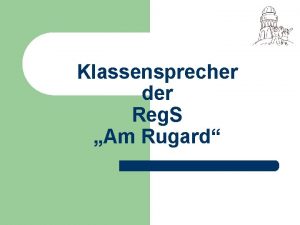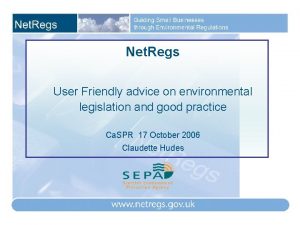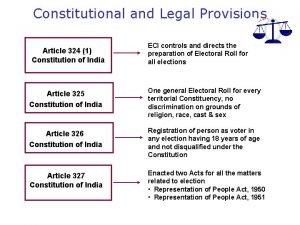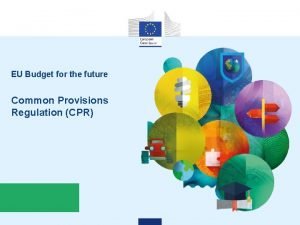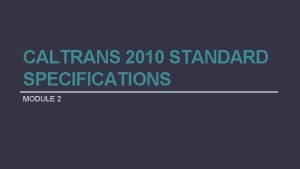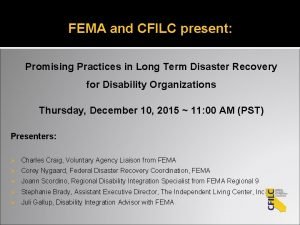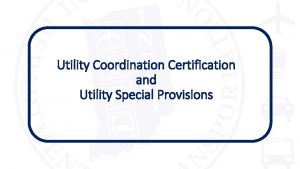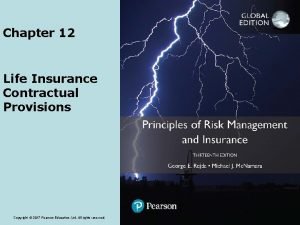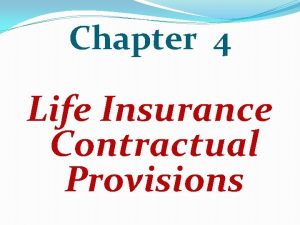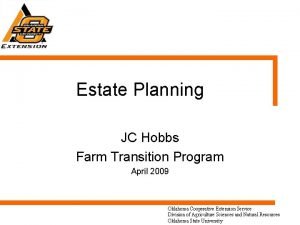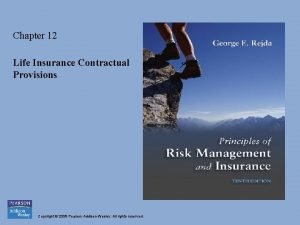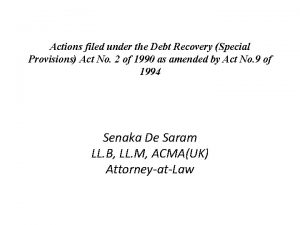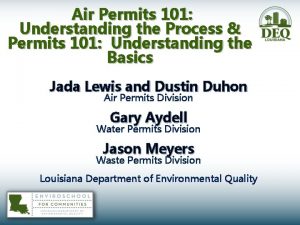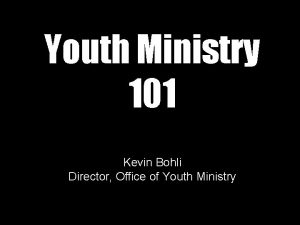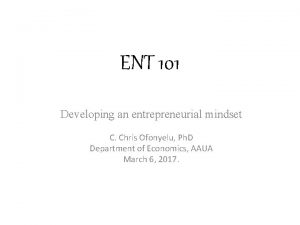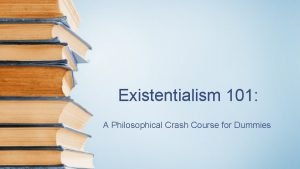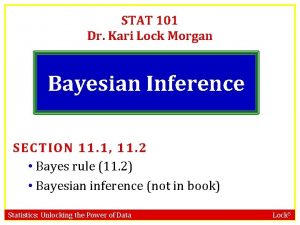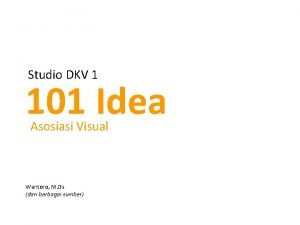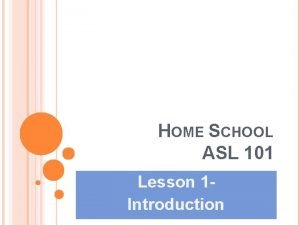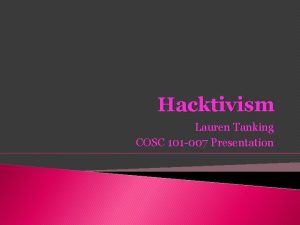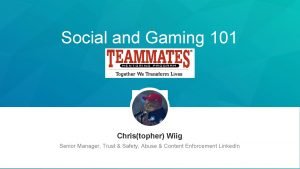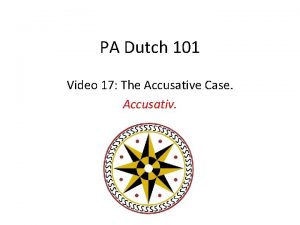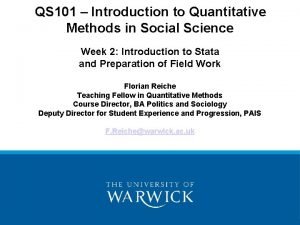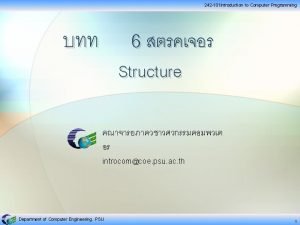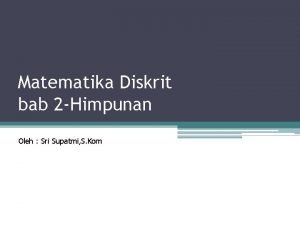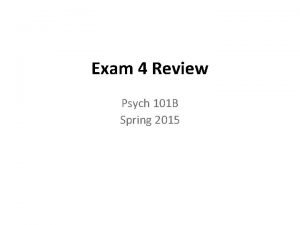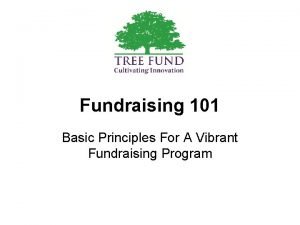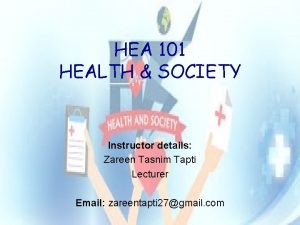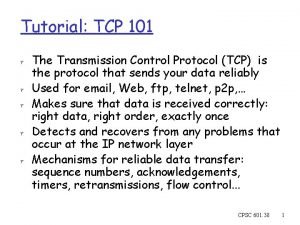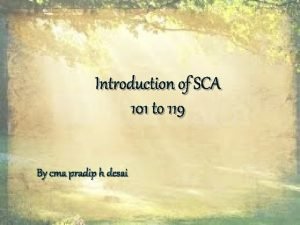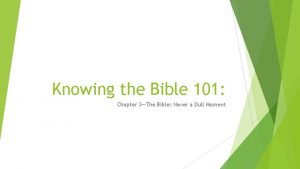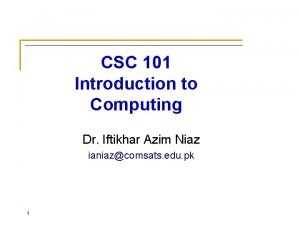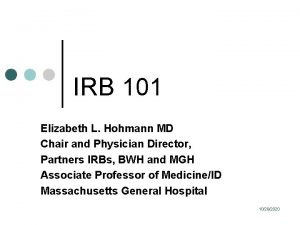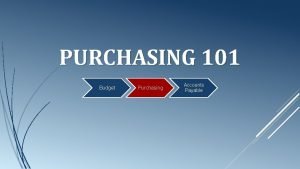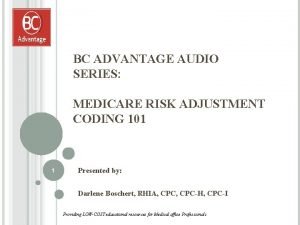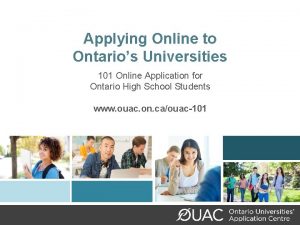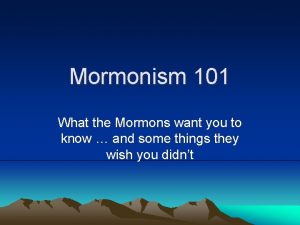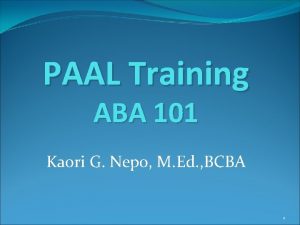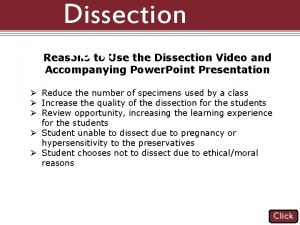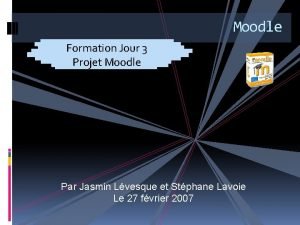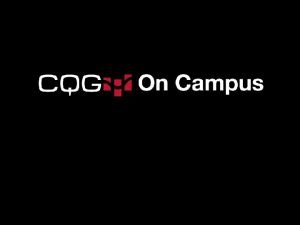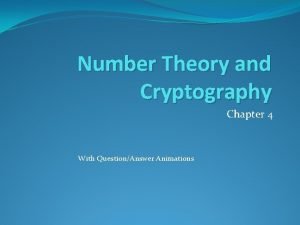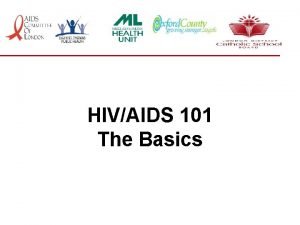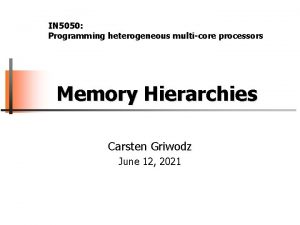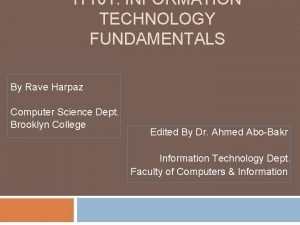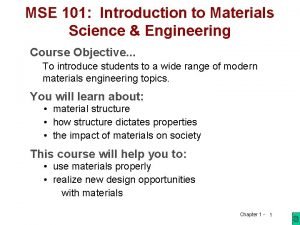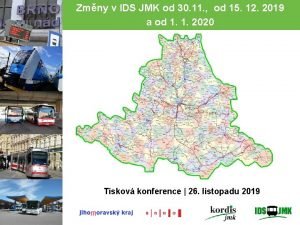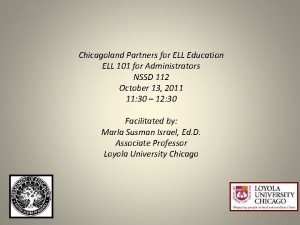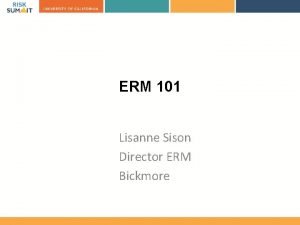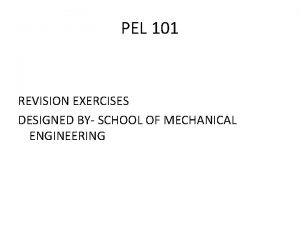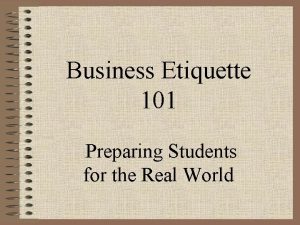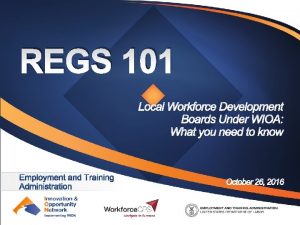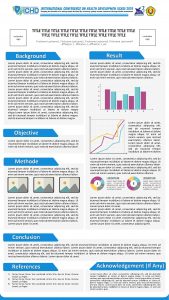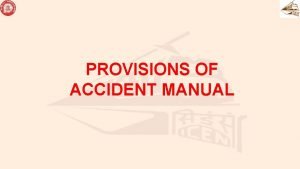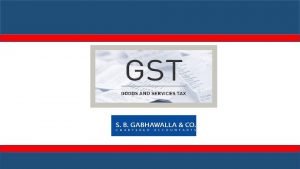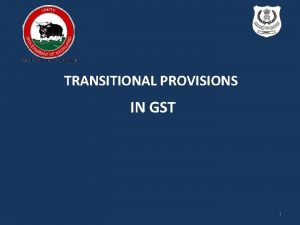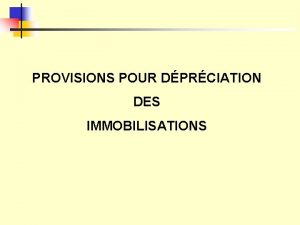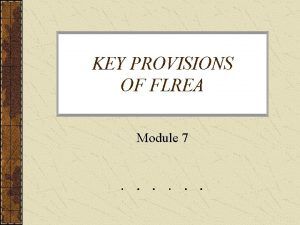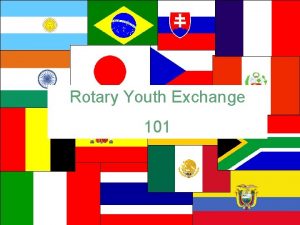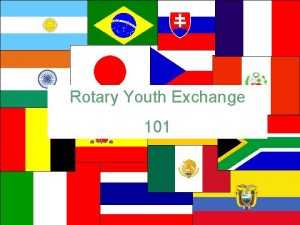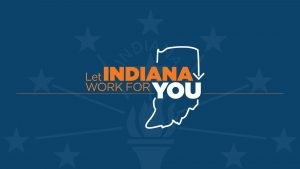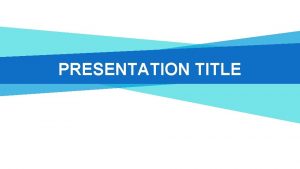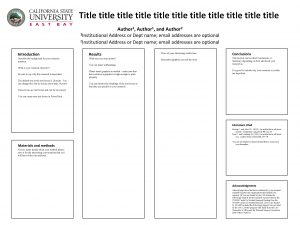1 REGS 101 Youth Provisions Title I Youth














































































- Slides: 78

1

REGS 101 Youth Provisions- Title I Youth Formula Program, Youth. Build and Re-entry Employment Opportunities July 27, 2016 2

Enter your location in the Chat window (lower left of screen) 3

v Federal v State v Local 4 v Labor and Workforce v Adult Education v Vocational Rehabilitation v TANF v Youth Service Providers v Other

Youth. Build Program Manager DOL/ETA/OWI/Division of Youth Services Youth Policy & Performance Program Manager DOL/ETA/OWI/Division of Youth Services 5

Program Analyst, Division of Youth Services 6

1. I’ve read all of the DOL only rule and the titlespecific rule for my program once, and I’m starting on a second reading. 2. Yes, I read Sections 681 and 688 cover to cover, but I’m still digesting the content. 3. I have reviewed the provisions of most interest to me. 4. So far, I’ve managed to find the final rules on the website. 7

ü Reviewing the Final Rule Sections 681 (WIOA Youth Formula program) and 688 (Youth. Build) ü Highlighting key changes in the Final Rules and how they impact youth programs ü Sharing how WIOA impacts the Re-entry Employment Opportunities grants (formerly REx. O) ü Sparking enthusiasm for your role in supporting young adults, ages 14 -24 8

v 3: 00 | Overview of Youth Workforce Development Themes in WIOA Final Rule v 3: 10 | Key Impacts of the Final Rule on Youth. Build and Re-entry Employment Opportunities Programs v 3: 20 | Key Impacts of the Final Rule on the WIOA Youth Formula Program v 4: 10 | Q&A and Final Remarks 9

Jennifer Kemp & Jenn Smith 10

v The workforce system will be characterized by three critical hallmarks of excellence: ® The needs of business and workers drive workforce solutions; ® One-Stop Centers (or American Job Centers) provide excellent customer service to jobseekers and employers and focus on continuous improvement; and ® The workforce system supports strong regional economies and plays an active role in community and workforce development. 11

The DOL Only Final Rule Preamble outlines a clear vision for serving youth under WIOA: ® Emphasizes the connections across all of our youth -serving programs under WIOA. ® WIOA is an opportunity to align and coordinate service strategies for ETA youth training programs, as well as to align with our Federal partners that serve these same customers. ® Creates a seamless safety net of services for the most at-risk youth populations. 12 ® Across the system, continuous improvement is supported through evaluation, accountability, identification of best practices, and data driven decision making.

Jenn Smith 13

14 Participants are eligible for Youth. Build if they are: 1. not less than age 16 and not more than age 24, on the date of enrollment; 2. a member of a low-income family, a youth in foster care (including youth aging out of foster care), a youth offender, a youth who is an individual with a disability, a child of incarcerated parents, or a migrant youth; and 3. a school dropout, or an individual who was a school dropout and has subsequently reenrolled.

♦ Requires Youth. Build to be a One-Stop system partner – 678. 400 (Joint Rule) ♦ Clarifies Youth. Build as a pre-apprenticeship pathway program for Registered Apprenticeship – 688. 120 ♦ Codifies Construction Plus as an approved category of training – 688. 320 ♦ Includes requirement for six new WIOA performance measures for youth – 688. 400 15

• The maximum percentage of funds that may be used for supervision and training of participants on the rehabilitation of community and other public use facilities is increased from 10 percent to 15 percent. • The allowable administrative cost ceiling is reduced from 15 percent to 10 percent. 16

• • • Applicant Adjusted Income Basic Skills Deficient Construction Plus Exit In-Demand Industry Sector or Occupation • Individual with a Disability • Offender 17 • Pre-apprenticeship • Qualified National Nonprofit Agency • Recognized Postsecondary Credential • School Dropout • Secondary School • Supportive Services • Youth. Build Program • Youth in Foster Care

Pre-apprenticeship, as defined in § 681. 480 of this chapter, means a program designed to prepare individuals to enter and succeed in an apprenticeship program registered under the Act of August 16, 1937 (commonly known as the “National Apprenticeship Act”; 50 Stat. 664, chapter 663; 29 U. S. C. 50 et seq. )(referred to in this part as a “registered apprenticeship” or “registered apprenticeship program”) and includes the following elements: 18

1) Training and curriculum that aligns with the skill needs of employers in the economy of the State or region involved; 2) Access to educational and career counseling and other supportive services, directly or indirectly; 3) Hands-on, meaningful learning activities that are connected to education and training activities, such as exploring career options, and understanding how the skills acquired through coursework can be applied toward a future career; 4) Opportunities to attain at least one industry-recognized credential; and 5) A partnership with one or more registered apprenticeship programs that assists in placing individuals who complete the pre-apprenticeship program in a registered apprenticeship program. Youth. Build programs that receive funding under this part are considered pre-apprenticeship programs under this definition. 19

• • 20 The Youth Formula Activities have a new requirement under WIOA that they must spend at least 75% of available funds on out-of-school youth. This requirement does not impact Youth. Build, which predominantly serves out-of-school youth already. However, Youth. Build programs should be aware of the Youth Formula Activities definition of out-of-school youth and where that may or may not align with the Youth. Build definition of a participant as someone who is, or has been, a drop-out. Importantly, the Youth Formula Activities focus on OSY revises the age of youth eligible for these services to 16 -24, which now perfectly aligns with the Youth. Build eligible age range. Additionally, some of the sources of documentation for eligibility for Youth Formula differ from those allowable for Youth. Build eligibility is defined in sec. 171 of WIOA.

v Separate from WIOA, two changes were made to the Youth. Build Final Rule: • Restrictive covenant period – reduced from ten-year to five-year period as a minimum – 688. 730 • Inclusion of HUD Section 3 definition – 688. 120 21

v REO (formerly REx. O) is a pilot and demonstration grant program. v REO is authorized under WIOA sec. 225 – Programs for Corrections Education and Other Institutionalized Individuals, as well as under the Second Chance Act of 2007 sec. 212 – Responsible Reintegration of Offenders. 22

v Additionally, § 678. 400 of the Joint Rule requires REO to be a One-Stop partner and § 676. 143 and 361. 140 of the Joint Rule specify REO grants as one of the partner programs to be included in the Unified and Combined State Plans. v To further improve WIOA alignment, REO is reporting using the six WIOA performance measures (for youth and adults, depending on the target population of specific grant pilots). 23

Jennifer Kemp and Evan Rosenberg 24

v WIOA eliminates Youth Council requirement; however, DOL encourages WDBs to establish a standing youth committee v Flexibility in Membership – Standing Youth Committee should reflect needs of local area and must include: üMember of local WDB as chair üCommunity-based organizations with record of success üOthers with appropriate expertise and experience v WDBs may designate existing effective youth council as standing youth committee 25

v An out-of-school youth (OSY) must be each of the following: ® Not attending any school (as defined under State law); ® Not younger than age 16 or older than age 24 at time of enrollment - age eligibility is based on age at enrollment (i. e. , age at eligibility determination); therefore, participants may continue to receive services beyond the age of 24 once they are enrolled in the program; and ® Have one or more of the following 9 “barriers. ” 26

v (1) A school dropout; v (2) A youth who is within the age of compulsory school attendance, but has not attended school for at least the most recent complete school year calendar quarter; v (3) A recipient of a secondary school diploma or its recognized equivalent who is a low-income individual and is either basic skills deficient or an English language learner; v (4) An offender; v (5) A homeless individual, a homeless child or youth, or a runaway; 27

28 v (6) An individual in foster care or who has aged out of the foster care system or who has attained 16 years of age and left foster care for kinship guardianship or adoption, a child eligible for assistance under sec. 477 of the Social Security Act (42 U. S. C. 677), or in an out-of-home placement; v (7) An individual who is pregnant or parenting; v (8) An individual with a disability; or v (9) A low-income individual who requires additional assistance to enter or complete an educational program or to secure or hold employment.

v Only 2 of the 9 types of barriers require an individual to be low income: ® (3) A recipient of a secondary school diploma or its recognized equivalent who is a lowincome individual and is either basic skills deficient or an English language learner; ® (9) A low-income individual who requires additional assistance to enter or complete an educational program or to secure or hold employment. v All other OSY barriers do not require the individual to be low income 29

v An in-school youth (ISY) must be each of the following: ® Attending school (as defined by State law), including secondary and post-secondary school; ® Not younger than age 14 or (unless an individual with a disability who is attending school under State law) older than age 21 at time of enrollment - age eligibility is based on age at enrollment (i. e. , age at eligibility determination); therefore, participants may continue to receive services beyond the age of 21 once they are enrolled in the program; ® A low-income individual; and ® Have one or more of the following 8 barriers. 30

v (1) Basic skills deficient; v (2) An English language learner; v (3) An offender; v (4) A homeless individual, a homeless child or youth, or a runaway; v (5) An individual in foster care or has aged out of the foster care system or who has attained 16 years of age and left foster care for kinship guardianship or adoption, a child eligible for assistance under sec. 477 of the Social Security Act (42 U. S. C. 677), or in an out-of-home placement; . 31

v (6) An individual who is pregnant or parenting; v (7) An individual with a disability; or v (8) An individual who requires additional assistance to complete an educational program or to secure or hold employment. 32

v Low income applies to all ISY ® Youth w/ a disability based on own income rather than family v WIOA includes 2 new ways to document low income: ® For ISY, if eligible to receive a free or reduced price lunch under the Richard B. Russell National School Lunch Act ® If youth lives in a high poverty area (defined as at least 25% poverty rate) v WIOA allows a low-income exception where 5% of WIOA youth may be participants who ordinarily would be required to be lowincome for eligibility purposes and meet all other eligibility criteria for WIOA youth except the low-income criteria. 33

v Must have a definition at State or Local Level ® If State defines it, definition must be included in state plan ® If State does not define it, Local Area must define it in local plan v Limitation of additional assistance barrier for ISY: ® Not more than 5% of ISY newly enrolled in a program year may be eligible based on this barrier 34

v The Department does not consider the following to be schools: ® providers of adult education under title II of WIOA, ® the Youth. Build program, ® the Job Corps program, ® high school equivalency programs, ® or dropout re-engagement programs 35

• Therefore, in all cases with one exception, a youth is an OSY for purposes of WIOA youth program eligibility if he or she attends any of the above • Exception: youth attending high school equivalency programs funded by the public K-12 school system who are classified by the school system as still enrolled in school are considered ISY 36

v School status is based on status at time of enrollment (i. e. , time of eligibility determination) v School status does NOT change during the program v Example: an individual who is out of school at the time of enrollment, and subsequently placed in any school, is an OSY for the purposes of the minimum 75 percent expenditure requirement for OSY throughout his/her participation in the program. 37

v In order to be considered a youth participant, all of the following must occur: ® (1) The collection of information to support an eligibility determination; ® (2) The provision of an objective assessment; and ® (3) Participation in any of the 14 WIOA youth program elements. 38

v Significant change from WIA to WIOA: grant recipient/fiscal agent has the option to provide directly some or all of the youth workforce investment activities. v Competitive procurement provision in WIOA sec. 123 only applicable if the Local WDB chooses to award grants or contracts to youth service providers. v Department encourages Local WDBs to continue to award contracts to youth service providers when local areas have experienced and effective youth service providers 39

v If local WDB chooses to contract with service providers, they must: ® Identify providers based on criteria in state plan ® Procure service providers in accordance with the Uniform Guidance at 2 CFR parts 200 and 2900, and applicable State and local procurement laws v If WDB establishes youth committee, may assign it to select contracts v Where the WDB determines an insufficient number of eligible youth providers in the local area, such as a rural area, the WDB may award contracts on a sole source basis 40

v OSY expenditure requirement applies to both statewide and local youth funds v For local area funds, the administrative costs of carrying out local workforce investment activities are not subject to the OSY expenditure requirement v Only statewide funds spent on direct services to youth are subject to OSY expenditure requirement v States that receive a small State minimum allotment for youth or adults may request to decrease the percentage to not less than 50 percent for a local area in the State ® Annual allotment TEGL lists states that receive small State minimum allotment 41

v Objective assessment that includes review of participant’s: ® skill levels ® service needs ® strengths Ø May use recent objective assessment from another program if appropriate v Individual Service Strategy (ISS), which must be updated as needed ® based on needs of participant and objective assessment ® linked to one or more performance indicators ® Identifies career pathways, including education and employment goals Ø May use recent ISS from another program if appropriate v Case Management, including follow-up services 42

v Local WDBs must ensure appropriate links to entities that will foster the participation of youth, including: ® ® ® (1) Local area justice and law enforcement officials; (2) Local public housing authorities; (3) Local education agencies; (4) Local human service agencies; (5) WIOA title II adult education providers; (6) Local disability-serving agencies and providers and health and mental health providers; ® (7) Job Corps representatives; and ® (8) Representatives of other area youth initiatives, such as Youth. Build, and including those that serve homeless youth and other public and private youth initiatives. 43

v Local WDBs must ensure that WIOA youth service providers meet the referral requirements for all youth participants, including: ® Providing participants with information about applicable or appropriate services available through the Local WDBs or other eligible providers, or onestop partners ® Referring participants to appropriate training and educational programs that have the capacity to serve them either on a sequential or concurrent basis 44 v If youth apply for program and are not eligible or local area cannot serve them, they must refer them to an appropriate program

v Local WDBs must ensure that parents, youth participants, and other members of the community with experience relating to youth programs are involved in design and implementation of youth programs 45

v WDBs may implement a WIOA Pay-for. Performance contract strategy for program elements for which the Local WDB may reserve and use not more than 10 percent of the total funds allocated to the local area 46

v Youth can be co-enrolled in adult program if they meet eligibility for both programs ® 18 -24 year olds eligible for both adult and youth should be enrolled in specific program(s) based on assessment and services needs of participant v Youth can also be co-enrolled in Title II program if they meet eligibility for both v No limit on length of service in Youth program ® Serve for amount of time necessary for youth to successfully enter employment or postsecondary education 47

v Local programs must make all 14 program elements available to youth v Local programs determine which elements a youth receives based on the assessment and ISS v A program doesn’t need to provide every service to each participant 48

v Local programs should partner with entities that can provide program elements at no cost ® Do not need to spend WIOA youth funds on every program element, can leverage resources to provide some elements without using WIOA youth funds ® Must have agreement with partners to provide leveraged elements 49

1) Tutoring, study skills training, instruction and evidence-based dropout prevention and recovery strategies that lead to completion of the requirements for a secondary school diploma or its recognized or for a recognized postsecondary credential; 2) Alternative secondary school services, or dropout recovery services, as appropriate; 3) Paid and unpaid work experiences that have academic and occupational education as a component of the work experience, which may include the following types of work experiences: ® (i) Summer employment opportunities and other employment opportunities available throughout the school year; ® (ii) Pre-apprenticeship programs; ® (iii) Internships and job shadowing; and ® (iv) On-the-job training opportunities; 50

4) Occupational skill training, which includes priority consideration for training programs that lead to recognized postsecondary credentials that align with in-demand industry sectors or occupations in the local area involved; 5) Education offered concurrently with and in the same context as workforce preparation activities and training for a specific occupation or occupational cluster; 6) Leadership development opportunities, including community service and peer-centered activities encouraging responsibility and other positive social and civic behaviors; 7) Supportive services 8) Adult mentoring for a duration of at least 12 months, that may occur both during and after program participation; 9) Follow-up services for not less than 12 months after the completion of participation; 51

10) Comprehensive guidance and counseling, which may include drug and alcohol abuse counseling, as well as referrals to counseling, as appropriate to the needs of the individual youth; 11) Financial literacy education; 12) Entrepreneurial skills training; 13) Services that provide labor market and employment information about in-demand industry sectors or occupations available in the local area, such as career awareness, career counseling, and career exploration services; and 14) Activities that help youth prepare for and transition to postsecondary education and training. 52

Pre-apprenticeship, as defined in § 681. 480 of this chapter, means a program designed to prepare individuals to enter and succeed in an apprenticeship program registered under the Act of August 16, 1937 (commonly known as the “National Apprenticeship Act”; 50 Stat. 664, chapter 663; 29 U. S. C. 50 et seq. )(referred to in this part as a “registered apprenticeship” or “registered apprenticeship program”) and includes the following elements: 53

1) Training and curriculum that aligns with the skill needs of employers in the economy of the State or region involved; 2) Access to educational and career counseling and other supportive services, directly or indirectly; 3) Hands-on, meaningful learning activities that are connected to education and training activities, such as exploring career options, and understanding how the skills acquired through coursework can be applied toward a future career; 4) Opportunities to attain at least one industry-recognized credential; and 5) A partnership with one or more registered apprenticeship programs that assists in placing individuals who complete the pre-apprenticeship program in a registered apprenticeship program. 54

v Last at least 12 months and may take place both during the program and following exit from the program. v Be a formal relationship between a youth participant. v While group mentoring activities and mentoring through electronic means are allowable as part of the mentoring activities, at a minimum, the local youth program must match the youth with an individual mentor with whom the youth interacts on a face-toface basis. v Mentoring may include workplace mentoring where the local program matches a youth participant with an employer or employee of a company. 55

v create budgets, initiate checking and savings accounts v manage spending, credit, and debt, including student loans, consumer credit, and credit cards; v teach participants about the significance of credit reports and credit scores v understand, evaluate, and compare financial products, services, and opportunities and to make informed financial decisions v educate about identity theft, ways to protect themselves from identify theft, and how to resolve cases of identity theft 56

v This includes drug and alcohol abuse counseling, mental health counseling, and referral to partner programs, as appropriate. v When referring participants to necessary counseling that cannot be provided by the local youth program or its service providers, the local youth program must coordinate with the organization it refers to in order to ensure continuity of service. 57

Opportunities that encourage responsibility, confidence, employability, self-determination, and other positive social behaviors such as: v Community and service learning projects v Peer-centered activities, including peer mentoring and tutoring v Organizational and team work training, including team leadership training 58

v Self-esteem building v Working with individuals from diverse backgrounds; v Maintaining healthy lifestyles, including being alcohol- and drug-free; v Positive job attitudes and work skills. 59

v Individual Training Accounts (ITAs) are allowable for OSY (16 -24) v ITAs are not allowed for ISY v ISY 18 and over may co-enroll in the adult program 60

v Seek out and identify business opportunities v Develop budgets and forecast resource needs v Understand various options for acquiring capital and the trade-offs associated with each option v Communicate effectively and market oneself and one’s ideas. 61

v Entrepreneurship education that provides an introduction to the values and basics of starting and running a business. v Enterprise development which provides supports and services that incubate and help youth develop their own businesses. v Experiential programs that provide youth with experience in the day-to-day operation of a business. 62

Services include, but are not limited to, the following: a) Linkages to community services; b) Assistance with transportation; c) Assistance with child care and dependent care; d) Assistance with housing; e) Needs-related payments; f) Assistance with educational testing; g) Reasonable accommodations for youth with disabilities; h) Legal aid services; i) Referrals to health care; j) Assistance with uniforms or other appropriate work attire and work-related tools, including such items as eyeglasses and protective eye gear; k) Assistance with books, fees, school supplies, and other necessary items for students enrolled in postsecondary education classes; and l) Payments and fees for employment and training-related applications, tests, and certifications. 63

v All youth participants must be offered follow-up services and follow-up services must be provided for a minimum of 12 months unless participant declines them or cannot be located v Type of follow-up services based on needs of individual (and may be longer than 12 months if needed) v Follow-up services must be more than a contact attempted or made for sole purpose of securing documentation for reporting 64

v Follow-up services may include regular contact with a youth participant's employer, including assistance in addressing work-related problems v Follow-up services may include the following program elements: 1) 2) 3) 4) Supportive services; Adult mentoring; Financial literacy education; Services that provide labor market and employment information about in-demand industry sectors or occupations available in the local area, such as career awareness, career counseling, and career exploration services; and 5) Activities that help youth prepare for and transition to post-secondary education and training. 65

v Local youth programs must expend not less than 20 percent of the funds allocated to them to provide ISY and OSY with paid and unpaid work experiences v Local WIOA youth programs must track and report program funds spent on paid and unpaid work experiences v The percentage of funds spent on work experience is based on total local area youth funds expended for work experience rather than calculated separately for ISY and OSY v Local area administrative costs are not subject to the 20 percent minimum work experience expenditure requirement 66

v Local youth programs must expend not less than 20 percent of the funds allocated to them to provide ISY and OSY with paid and unpaid work experiences v Local WIOA youth programs must track and report program funds spent on paid and unpaid work experiences v The percentage of funds spent on work experience is based on total local area youth funds expended for work experience rather than calculated separately for ISY and OSY v Local area administrative costs are not subject to the 20 percent minimum work experience expenditure requirement 67

v WIOA does not require Local WDBs to offer summer youth employment opportunities. v WIOA does require Local WDBs to offer work experience opportunities using at least 20 percent of their funding, which may include summer employment. 68

v What does education offered concurrently with and in the same context as workforce preparation activities and training for a specific occupation or occupational cluster mean? v Reflects an integrated education and training model and describes how workforce preparation activities, basic academic skills, and hands-on occupational skills training are to be taught within the same time frame. 69

v Incentive payments to youth participants are permitted for recognition and achievement directly tied to training activities and work experiences v The local program must have written policies and procedures in place governing the award of incentives and must ensure that such incentive payments are 70 ® Tied to the goals of the specific program; ® Outlined in writing before the commencement of the program that may provide incentive payments; ® Align with the local program’s organizational policies; and ® Accord with the requirements contained in 2 CFR part 200.

v Local WDBs and programs must provide opportunities for parents, participants, and other members of the community with experience working with youth to be involved in the design and implementation of youth programs v Ways to get involved could include: ® serving on youth standing committees ® serving as mentors ® serving as tutors ® providing input into the design and implementation of other program design elements 71

v Youth program is a required One-Stop partner and must fulfill the roles and responsibilities of a One-Stop partner v Local WDBs must either co-locate WIOA youth program staff at One-Stop Centers and/or ensure One -Stop Centers and staff are trained to serve youth and equipped to advise youth v Other connections with One-Stops may include: ® The coordination and provision of youth activities; ® Linkages to the job market and employers; ® Access for eligible youth to the information and services required in § 681. 460; ® Services for non-eligible youth, such as basic labor exchange services, other self-service activities such as job searches, career exploration, use of career center resources, and referral as appropriate. 72

v Local WDBs must ensure One-Stop Centers fund services for non-eligible youth through programs authorized to provide services to such youth v One-Stop Centers may provide basic labor exchange services under the Wagner-Peyser Act to any youth 73

v TEGL 23 -14: “Workforce Innovation and Opportunity Act (WIOA) Youth Program Transition” v TEGL 08 -15: “Second Title 1 WIOA Youth Program Transition Guidance” v TEGL 06 -15: “Qualifying Work Sites and Construction Projects for Youth. Build Grantees and Their Role in Training" 74

v ION – Innovation and Opportunity Network Community of Practice: https: //ion. workforcegps. org/ v Get my Future – the latest web and mobile app platform for youth to find resources, services and career exploration tools: http: //www. careeronestop. org/Get. My. Future/index. aspx 75

v Youth. Build WIOA FAQ sheet, available on the Youth. Build Community of Practice: https: //youthbuild. workforcegps. org/resources/201 6/03/25/09/57/Youth. Build-WIOA-FAQ-Sheet 76

Enter your questions in the Chat window (lower left of screen) 77

78
 Regs am rugard
Regs am rugard Netregs
Netregs 2015 nehrp recommended seismic provisions
2015 nehrp recommended seismic provisions Legal provisions
Legal provisions Fidelity personal trust services
Fidelity personal trust services Common provisions regulation for shared management funds
Common provisions regulation for shared management funds 2010 caltrans standard plans
2010 caltrans standard plans Fema provisions
Fema provisions Utility coordination
Utility coordination Life insurance contractual provisions
Life insurance contractual provisions Life insurance contractual provisions
Life insurance contractual provisions New hobbs farm and provisions
New hobbs farm and provisions Note 3 ways war affected the land and people of europe
Note 3 ways war affected the land and people of europe Life insurance contractual provisions
Life insurance contractual provisions Define decree nisi
Define decree nisi Understanding air permits
Understanding air permits Kevin bohli
Kevin bohli Title title
Title title Title fly of a report
Title fly of a report Cyber insurance 101
Cyber insurance 101 Ent 101
Ent 101 Existentialism crash course philosophy #16 transcript
Existentialism crash course philosophy #16 transcript Cold calling 101
Cold calling 101 Ghy 1010
Ghy 1010 Stat 101
Stat 101 101 idea
101 idea Supercalifragilisticexpialidocious
Supercalifragilisticexpialidocious 101 builders
101 builders Chem 101
Chem 101 Find an inverse of 101 modulo 4620
Find an inverse of 101 modulo 4620 Cosc 101
Cosc 101 Pc gaming 101
Pc gaming 101 Accusative pronouns
Accusative pronouns Qs 101
Qs 101 Stat 101
Stat 101 #รบสต
#รบสต Diantara bilangan bulat antara 101 - 600
Diantara bilangan bulat antara 101 - 600 Psych 101 exam 4
Psych 101 exam 4 Principles and techniques of fundraising
Principles and techniques of fundraising Hea 101
Hea 101 500 101
500 101 Tcp 101
Tcp 101 Tcp 101
Tcp 101 Workday 101
Workday 101 What are refined grains
What are refined grains Sca 101
Sca 101 Knowing the bible 101
Knowing the bible 101 It 101 - introduction to computing
It 101 - introduction to computing Irb 101
Irb 101 Greenhouse effect
Greenhouse effect Accounts payable 101
Accounts payable 101 101 rue de tolbiac
101 rue de tolbiac Medicare advantage risk adjustment 101
Medicare advantage risk adjustment 101 Ouac 101
Ouac 101 Ouac 101 application
Ouac 101 application Mormonism 101
Mormonism 101 Mortgage hedging 101
Mortgage hedging 101 Aba 101
Aba 101 Dissection 101 sheep heart quiz
Dissection 101 sheep heart quiz Moodle catolica
Moodle catolica Technical analysis 101
Technical analysis 101 Stem robotics 101
Stem robotics 101 Islam 101 powerpoint
Islam 101 powerpoint Find an inverse of 101 modulo 4620
Find an inverse of 101 modulo 4620 What does hiv stand
What does hiv stand Allone cloud disk drive 101 ramdisk
Allone cloud disk drive 101 ramdisk It 101
It 101 Mse 101
Mse 101 Ids jmk mapa
Ids jmk mapa Business blogging 101
Business blogging 101 Ell 101
Ell 101 Porn101
Porn101 Wrestling parent meeting agenda
Wrestling parent meeting agenda Erm 101
Erm 101 School revision 101
School revision 101 Diversity examples
Diversity examples Hecker 101
Hecker 101 Physics 101 lecture
Physics 101 lecture Itp 101
Itp 101
